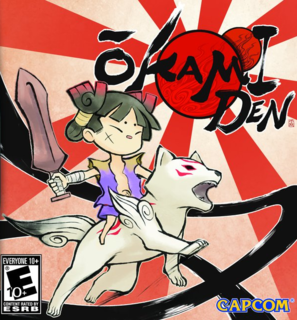I’ve noticed how people are often referring back to the prequel Okami. Since I can’t input anything that hasn’t already been said about the comparison between Okami and Okamiden, I’ll try to keep this as a review on the game as a whole without referring back to Okami.
I like the game as a whole overall. I loved the Traditional Japanese aesthetic so much, that it’s one of the main factors that got me into Japanese culture in the first place. The game-play and narrative of the game added to the experience as it further immersed me into the world it created. But what elements does Okamiden have to offer in terms of game-play? How does this game incorporate the Traditional Japanese aesthetic so well?
To start off, you have to fight demons of varying difficulty in battles and in the field using a variety of weapons. Whether the enemies are relatively easy or hard, there’s always a certain trick to gain the upper hand easier from combat tactics or strategy, such as weapon choice, or how you use your celestial brush. For example, certain weapons allow you to do more damage per hit while sacrificing attack speed(such as the Tsumugari), or weapons that sacrifices damage per hit to boost attack speed(such as the Devout beads). This allows for some weapon variety which I like since I don’t always want to be using the same weapon for the entire game. On the other hand, the Celestial brush allows you to stop time, and draw certain brush strokes on a canvas to affect the environment in different ways. For example in battle, you can draw a straight line through an enemy to instantly slash through them(Powerslash). Damaging brush techniques deal more or less damage depending on the target enemy. There are also brush techniques you can use outside of battle such as Bloom, which can be used to revive dead cherry blossom trees(Which may or may not open new paths); and Rejuvenation, which can be used to repair broken objects or platforms. So other than use in combat, the celestial brush can also help you interact with the environment around you to unlock new paths in the game.
So why did this game have you battle demons with beads and reflectors when they can seemingly be replaced with any other enemies or objects other games have? It’s due to Okamiden trying to take on a Traditional Japanese aesthetic. It produces this beautiful atmosphere with watercolor graphics topped with its calligraphy font, use of Japanese instruments in its soundtrack, and its integration of Japanese related objects into its game-play. Its graphics make it so that only the major lines in a setting are bolded in black, while others are blurred with each other to create a watercolor style. It’s shown when you draw strokes where not only are you drawing with a calligraphy brush, but the background also turns into a mono-color canvas to give the effect that you’re drawing on the background like it’s a canvas. Another aspect of its aesthetic is its soundtrack, and use of Japanese instruments; creating the appropriate atmosphere during game-play. The game’s rules define the environment of the game as a traditional Japanese setting, allowing the player to be immersed in what a traditional Japanese environment might be like as Chibiterasu. They also reward the player for thinking outside of the box, like discovering secrets on the field which may or may not require other conditions to be completed in order to even gain access to them, and also landing the correct finishing moves during combat (floral finishers) to gain parts for better weapons in the game. Although these are not requirements for beating the game, they add that extra spice to the game’s experience.
Overall, I liked the overall experience in Okamiden. Although the battles were relatively easy, and the puzzles aren’t particularly challenging, the experience I had from playing Okamiden more than makes up for it.

